|

Illustrator Christopher Denise first ventured into Brian Jacques' world of Redwall Abbey with The Great Redwall Feast,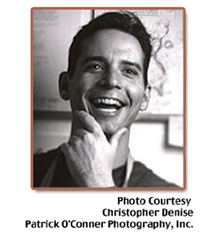 a beautifully illustrated 64-page storybook about Bobbatan Weary Nods, feasts, Bungo the Molebabe, and Abbey life in general. Since then, he's returned to Mossflower country twice, first with A Redwall Winter's Tale, then with The Redwall Cookbook, delighting fans with his incredible illustrations. a beautifully illustrated 64-page storybook about Bobbatan Weary Nods, feasts, Bungo the Molebabe, and Abbey life in general. Since then, he's returned to Mossflower country twice, first with A Redwall Winter's Tale, then with The Redwall Cookbook, delighting fans with his incredible illustrations.
I recently had the opportunity to interview Christopher, who was kind enough to take the time to give us some insight into his approach to Redwall.
You can find out more about Christopher Denise at his website, www.christopherdenise.com.
Enjoy the interview!
Martin (The Long Patrol): First, let me thank you for taking the time for this interview! To start off, how did you become a children's book illustrator? Had you always wanted to be one?
Christopher Denise (Redwall Illustrator): I never had any intention of becoming a children's book illustrator, I sort of fell into the career. I knew I liked making art, so I left St. Lawrence University and transferred to Rhode Island School of Design. I remember while at RISD I had an assignment to create this illustration using an animal of our choice doing something specific. I think my animal was racoons and the subject was things you do at camp. Honestly, I 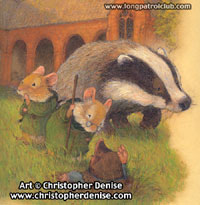 thought I was way too cool to do something like that. I had been painting these big abstract paintings and when making illustrations they were always very cool and smart. But animals with clothes on? Forget it. I never finished the assignment. Fortunately, the teacher stayed on me and gave me another assignment. This time she had me illustrating scenes from Wind and the Willows. Somehow the writing grabbed me and became something that I could sink my teeth into. I really thought about the characters and what they should look like, their clothes, their houses, how they would walk and stand, etc. Then I surprised myself by really enjoying the process of making the art and people loved it. I ended up using those images to start my professional career when I was still a Junior in college to get freelance jobs with educational publishers. The rest is history. thought I was way too cool to do something like that. I had been painting these big abstract paintings and when making illustrations they were always very cool and smart. But animals with clothes on? Forget it. I never finished the assignment. Fortunately, the teacher stayed on me and gave me another assignment. This time she had me illustrating scenes from Wind and the Willows. Somehow the writing grabbed me and became something that I could sink my teeth into. I really thought about the characters and what they should look like, their clothes, their houses, how they would walk and stand, etc. Then I surprised myself by really enjoying the process of making the art and people loved it. I ended up using those images to start my professional career when I was still a Junior in college to get freelance jobs with educational publishers. The rest is history.
Martin: What sort of advice would you give to budding artists?
Christopher: Draw all the time. Think of yourself as a visual communicator and drawing is your basic language.
Martin: Can you recall how you first became involved with Redwall?
Christopher: My editor, Patti Gauch, showed Brian my first book, The Fool of The World and the Flying Ship. He wrote The Great Redwall Feast for me to illustrate.
Martin: How did you prepare for the job?
Christopher: Research and drawing. Lots of both. Research included reading the novels several times.
Martin: What is it like working with Brian Jacques?
Christopher: It is like reading his books. It's a blast. He is one of the great storytellers of our time and a close family friend.
Martin:
'The Great Redwall Feast' came out within my first month as a Redwall fan-- I think I'd only read five or six of the books by then (mind you, there were only eight of them at the time)-- so it really helped solidify my early conception of Redwall. I'm interested in learning what your perception of Redwall was at the time and has it changed any now, over ten years later?
Christopher: My perception of Redwall came from Brian's books and how it sparked my own imagination. I still see it that way because I think I did a great job. I know I did-Brian told me that I nailed it.
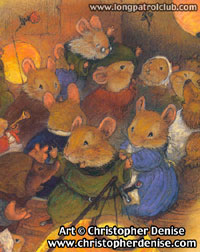 Martin: Have you been influenced at all by any of the other Redwall illustrators and their depictions of the same characters? Martin: Have you been influenced at all by any of the other Redwall illustrators and their depictions of the same characters?
Christopher: Not so much-I like much of what has been done. I think the TV show could have been pushed further, but I wasn't part of it and I am sure there were production constraints.
Martin: What's the illustrating process like? Is the story settled beforehand or are you able to suggest certain scenes that you'd like to draw? Who plots out where the text will go so you can draw around it and what are the various stages that the illustrations go through?
Christopher: It is pretty straight forward. Brian writes the yarn and sends it to me. I start sketching then design the book. Designing may not be the right word, as it is more akin to putting together a film. I show that work to my editor, my designer and Brian. If there are any kinks we work them out, then I make the art. The great thing is that they trust me and respect my vision and work.
(Note: To see Christopher's illustrative process, step-by-step, visit www.redwallwinter.com and click on "Creating an Illustration".)
Martin: How involved is Brian in the process?
Christopher: Without him the work would not exist. He creates the world. After that he hands it over to me. It's a big responsibility, but Brian has always had great faith in me and my work and knew that I understood what Redwall was and who the characters were.
Martin: I can still remember when 'A Redwall Winter's Tale' was first announced as forthcoming, followed by the "Season's Greetings" card you drew to tease it in 1999. And then the long (torturous) wait until its ultimate release in 2001. Given the wait for the book, I've always wondered, how long does it take to draw each page?
Christopher: It really depends on the complexity of the scene. I get this question often and it is tough to answer, because I work on four sometimes twelve pieces at once. When I am really moving along, I can get a piece out in a few days.
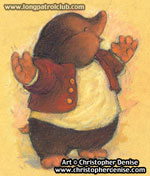 Martin: First popularized in The Great Redwall Feast, he's become something of the star of all of your collaborations with Brian: Bungo the Molebabe. What does Bungo represent, in your eyes, and why is he so loved? Martin: First popularized in The Great Redwall Feast, he's become something of the star of all of your collaborations with Brian: Bungo the Molebabe. What does Bungo represent, in your eyes, and why is he so loved?
Christopher: For me he represents part of Brian and all of us readers really as a kid.
Martin: Bungo was one of only five Redwall characters to receive the honor of being immortalized as a sculpture. What are your thoughts on that (and do you have it)?
Christopher: I do not have one. I remember seeing it while in NY at Philomel. I thought it looked great.
Martin: Your three Redwall books have all starred the original cast of characters-- Matthias, Cornflower, and the rest. How important to the books would you say that is-- having the original archetypes rather than an entirely new cast?
Christopher: Not something I really thought about. Perhaps Brian just could see those characters clearly in that type of book. I never questioned it. We had such fun with the characters in the first one that I was happy to continue exploring their personalities.
Martin: Some illustrators have found drawing anthropomorphic animals to be something of a challenge. How about you?
Christopher: Working with anthropomorphic characters is not something I anticipated exploring, but I have found it to be a challenge both intellectually and in terms of the craft that I truly enjoy. If you have a character that is a seafaring type, that can be interesting. But for me, it can be even more interesting if you make that character, say an otter, and start to think about how that otter might dance a jig. That is just the beginning of it, but you get the idea. How can you personify the attributes of the character that you are trying to convey to the reader/viewer through the suggested and inherent characteristics of that animal.
Martin: Do you ever sit and simply observe the animals you draw?
Christopher: Sure, when time permits. When it does not, research and drawing the shapes of the animals over and over to make them your own.
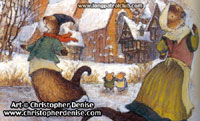 Martin: Is there a species (or character, for that matter) that you particularly enjoy drawing?
Martin: Is there a species (or character, for that matter) that you particularly enjoy drawing?
Christopher: Tough question. I like the variety, really, so I can play off the pose of one animal or the mass of one animal against another. I do like the otters quite a bit. They have opportunities to create interesting negative spaces in their poses.
Martin: One of the things that I absolutely loved about A Redwall Winter's Tale was its level of detail compared to The Great Redwall Feast, with Easter Eggs of sort for longtime fans. For example, the partial names of the Matthias & Methuselah bells that were visible on the bells themselves. The map of Mossflower seen behind Father Abbot on the first and last pages of the book. Even your depiction of (what I assume to be) the tapestry of Martin the Warrior on page 30. While there were a great many group illustrations in Feast, it always seemed like there was more going on in the background in Winter's. What changed between the two books?
Christopher: I was better suited for the challenge on Winter's Tale. I had never taken on a project that large when I started the Feast, I mean it was 64 pages long-that is a lot of illustration. Winter was longer, but I had done much of the leg work in terms of research and character development, so I could take the time to throw in a few more tidbits.
Martin: Speaking of the first and last pages of A Redwall Winter's Tale, 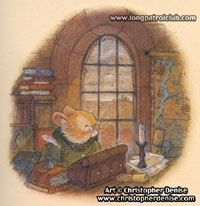 I've always gotten the impression that Father Abbot on those pages was supposed to represent you, sitting there at the drawing table, illustrating the story as we read it. Was he meant to be a stand-in for you? I've always gotten the impression that Father Abbot on those pages was supposed to represent you, sitting there at the drawing table, illustrating the story as we read it. Was he meant to be a stand-in for you?
Christopher: Not really. More a stand in for Brian, but that would even be a stretch. I see these characters as fully realized. I think there are parts of me in all the characters-that is how I connect with them and bring them to life. As an illustrator you need [to] also be an actor and as an actor you need to be versatile and play many parts.
Martin: Your latest collaboration, The Redwall Cookbook, is structured much differently from the first two books, centering around the various recipes for the meals at four seasonal feasts. How did the focus on recipes affect your job and did you try preparing any of the meals along the way (for visual aid)?
Christopher: The Cookbook was different because we had a lot of information that we needed in the book, but also needed to tell little stories. I really see it as four little books that can be read but also used as an actual cookbook. Unfortunately, no there was not time to prepare all the dishes, but we did try a few.
Martin: Another interesting thing about the Cookbook is that it's split into four parts-- Spring, Summer, Autumn, and Winter-- allowing you to tackle Redwall at all times of year. Did you enjoy that freedom and what season do you like to draw the most?
Christopher: Again, no favorites here. I did, however, enjoy the variety of light with each season and changing the palette accordingly.
Martin: I noticed you changed your depiction of Basil Stag Hare with the Cookbook, swapping out a simple blue coat for a regimental uniform. Why the switch?
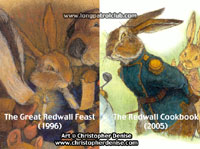 Christopher: It felt right. In the other two books, when I tried the full getup on Basil, it seemed to draw too much attention to itself and disrupted the visual flow.
Christopher: It felt right. In the other two books, when I tried the full getup on Basil, it seemed to draw too much attention to itself and disrupted the visual flow.
Martin: The Cookbook gave you the chance to draw a few more familiar Redwall faces-- Mattimeo, Jess Squirrel, Tim Churchmouse-- as well as introduce new characters like Basil's nephew and Ambrose Spike's cousin. Are there any other Redwall characters you haven't had the chance to draw yet that you'd like to?
Christopher: I did a very cool piece of Cluny once that I gave to Brian when he was visiting me. I'd like another crack at that villain.
Martin: Do you think you and Brian will collaborate again any time soon?
Christopher: You never know.....
Martin: What books, besides Redwall, have you worked on that you'd like fans to keep an eye out for?
Christopher: If you like my work check out all the books. Most are for younger readers, but I try to infuse them with the same degree of excitement and artistic integrity regardless of the audiences age. You should most certainly look at my most recent book, Pigs Love Potatoes. It is a fun little romp!
Martin: Any last words before we go?
Christopher: Keep an eye out for bigger and better things for my work, not just books but dim the lights and look to the silver screen!
Martin: Mr. Denise, thank you very much for the interview! It's been a pleasure!
Thanks again to Mr. Denise for taking the time to give The Long Patrol this exclusive interview!
|


 a beautifully illustrated 64-page storybook about Bobbatan Weary Nods, feasts, Bungo the Molebabe, and Abbey life in general. Since then, he's returned to Mossflower country twice, first with
a beautifully illustrated 64-page storybook about Bobbatan Weary Nods, feasts, Bungo the Molebabe, and Abbey life in general. Since then, he's returned to Mossflower country twice, first with 




